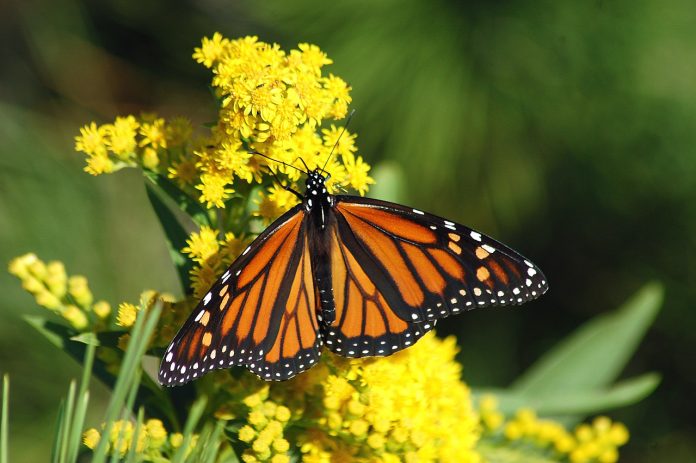Over the last 20 years, monarch butterfly populations that overwinter in the mountains of central Mexico have fluctuated wildly. Some years the species’ survival has been in doubt.
The news this year, however, is good.
Dr. Chip Taylor, director of Monarch Watch at the University of Kansas, monitors the status of monarchs each year, and he just issued his status report for 2017.
Before getting to Taylor’s expectations for the fall southbound migration, it’s important to understand how he arrives at his predictions. He begins with the numbers of monarchs measured at the overwintering sites in Mexico.
Environmental conditions. Next, he analyzes winter survival. Then he monitors the environmental conditions that monarchs experience as they move north from Mexico into Texas, Oklahoma, Louisiana, Arkansas and Kansas.
Then he assesses conditions during the breeding season that permit (or don’t permit) first-generation monarchs to reach the northern breeding grounds.
Summer temperatures and rainfall also factor into Taylor’s predictions. Based upon this year’s conditions, Taylor predicts a great fall season for monarchs.
Though monarch populations are usually highest in the Midwest and plains states, Cape May, N.J. is also known for its impressive fall monarch migration. Taylor expects numbers there to be much greater than in recent years.
A September or October trip to Cape May to see monarchs should be worthwhile. Taylor also predicts a great fall season for the Upper Midwest from the Dakotas east to Wisconsin, Illinois, Michigan, and Ohio.
And I’m expecting a good fall season here in northern West Virginia. I’ve been seeing lots of monarchs since early June.
Given his positive forecast, Taylor expects this fall to be a great opportunity for citizen scientists to tag monarchs.
Much of what we know about monarch migration originates with the citizen science program called Monarch Watch. Participants can purchase self-adhesive tags (25/$15) to place on the hind wings of captured monarchs.
Recovering tags
During the winter, tags recovered in Mexico help biologists understand the complexities of monarch migration. For more information and to purchase tags, visit www.monarchwatch.org.
For monarchs to continue a strong comeback this year, a variety of factors must converge.
Weather along the migratory path must be favorable. An abundant crop of nectar-bearing flowers to fuel the migration is required. And toxic herbicides applied by farmers along the migratory path must not have exterminated wildflowers, particularly milkweed.
Monarchs that make it to the winter grounds in Mexico must then survive three to four months before beginning their return migration.
Under ideal conditions, that’s not a problem, but cold temperatures and freezing rain in fir forests where monarchs winter can be catastrophic. Under adverse conditions, millions of monarchs can die.
So we cross our fingers and hope for the best. Until we have a sense of how many monarchs made it to the winter grounds, we must wait.
The more important number, however, is how many leave the winter grounds and head north in February. In the meantime, here’s what we can do to help monarch butterflies.
1. Plant milkweed. It’s the only host plant upon which monarchs lay eggs.
2. Plant more milkweed.
• • •
Solar Eclipse Alert: On Aug. 21, the U.S. will experience its first coast-to-coast total solar eclipse since 1776. From Oregon to South Carolina, the eclipse will follow a 67-mile wide path of totality.
In the zone of totality, the brightness of the sun will dim drastically, and the temperature could quickly and briefly drop as much as 20 degrees.
Animals will prepare for nightfall, and winds may pick up. Totality will last only a few minutes, but from start to finish the eclipse will take several hours. Outside the path of totality, the results will be far less dramatic.
Of course, all of this requires clear skies. Under a cloudy sky, the eclipse will occur almost unnoticed. Warning: Looking directly at the sun during a solar eclipse can cause severe damage to eyes and even blindness, so explain this to children and take proper precautions.
For tips on safely viewing the eclipse, visit www.nasa.gov.













